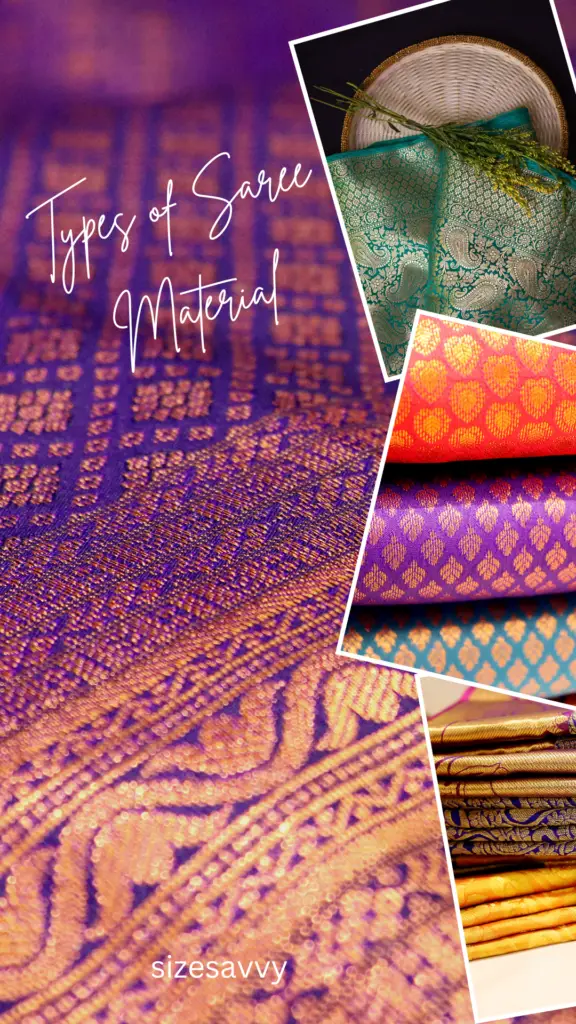What are the Different Types of Saree Materials? Saree’s garment comes in a wide variety of materials, each with its unique characteristics and appeal. Choosing the right saree material is essential to achieve the desired look and comfort.
Different types of Branded saree materials, their features, and how to care for them. Whether you’re new to this saree attire, this guide will help you make a better decision. Also, read our article on Types of Blouse Material. for more information.
Note: Always Know Your Saree Size. & choose the Branded blouse and Saree Color option before buying any saree material online.

Different Types of Saree Material and Their Characteristics
| Saree Material | Material Characteristic’s |
|---|---|
| Silk | Luxurious, elegant, and rich in texture and sheen |
| Cotton | Lightweight, breathable, and ideal for daily wear |
| Chiffon | Flowy, lightweight, and perfect for draping |
| Georgette | Soft, lightweight, and known for its crinkled texture |
| Net | Sheer and delicate with intricate designs |
| Crepe | Wrinkle-resistant, textured, and easy to drape |
| Satin | Smooth, glossy, and often used for formal occasions |
| Velvet | Luxurious, plush fabric with a soft and warm feel |
| Linen | Natural, breathable, and suitable for summer wear |
| Organza | Sheer, crisp, and often used for formal sarees |
- Silk: Silk sarees are renowned for their opulence and elegance. They come in various types such as Banarasi silk, Kanjivaram silk, and Tussar silk, each with its distinct weaving technique and patterns. Silk sarees are perfect for special occasions and add a touch of luxury to your ensemble.
- Cotton: Cotton sarees are lightweight, comfortable, and breathable, making them suitable for everyday wear. They come in different variations like handloom cotton, Kota cotton, and Chanderi cotton, known for their softness and durability. Cotton sarees are popular during summer and on casual occasions.
- Chiffon: Chiffon sarees are known for their sheer, lightweight fabric that drapes beautifully. They provide a graceful and flowy look, making them a popular choice for parties and events. Chiffon sarees often feature vibrant prints and embellishments.
- Georgette: Georgette sarees are made from a lightweight, semi-transparent fabric that has a slightly crinkled texture. They are comfortable to wear and drape effortlessly. Georgette sarees are versatile and can be worn for both casual and formal occasions.
- Net: Net sarees are crafted from sheer, open-weave fabric, creating a delicate and ethereal look. They are often adorned with intricate embroidery or sequins, making them perfect for glamorous events and weddings.
- Crepe: Crepe sarees have a unique texture and fall beautifully when draped. They are known for their wrinkle-resistant quality, which makes them a popular choice for formal occasions. Crepe sarees come in various types like silk crepe, georgette crepe, and chiffon crepe.
- Satin: Satin sarees are made from a smooth, glossy fabric that offers a luxurious and glamorous look. They are often chosen for special occasions like parties and weddings. Satin sarees come in a range of vibrant colors and are favored for their rich appearance.
- Velvet: Velvet sarees exude elegance and sophistication. They have a plush, soft texture and a subtle sheen. Velvet sarees are perfect for winter events and add a regal touch to your attire.
- Linen: Linen sarees are made from natural flax fibers, offering breathability and comfort, especially during the summer months. They have a crisp texture and are known for their understated elegance and simplicity.
- Organza: Organza sarees are lightweight, sheer, and have a crisp finish. They are often used for formal occasions and feature delicate embroidery or embellishments. Organza sarees create a sophisticated and graceful look.
Conclusion: Choosing the right saree material is crucial to enhance your overall look and comfort. Whether you prefer the richness of silk, the simplicity of cotton, or the ethereal beauty of chiffon, there is a saree material for every occasion and preference.
Consider the occasion, climate, and personal style when selecting the perfect saree material. With this list, you can confidently explore the world of sarees and make a statement with your saree outfit.
FAQs on Saree Materials
How do I choose the right saree material?
When choosing a saree material, consider factors such as the occasion, weather, and personal comfort. For formal events, silk or velvet sarees offer an elegant look, while cotton or linen sarees are ideal for casual wear or hot climates.
Are silk sarees suitable for everyday wear?
Silk sarees are typically reserved for special occasions due to their luxurious and rich nature. However, lighter variants like Tussar silk or art silk sarees can be worn more frequently for semi-formal events or gatherings.
Can I machine wash all types of sarees?
It is recommended to check the care instructions specific to each saree material. While some sarees like cotton and linen can generally be machine washed, delicate fabrics like silk, chiffon, or net may require gentle handwashing or dry cleaning.
How can I maintain the quality of my sarees?
To maintain the quality of your sarees, it’s essential to follow the care instructions provided by the manufacturer. Avoid exposing delicate sarees to direct sunlight for extended periods and store them in a cool, dry place to prevent damage.
Can I wear georgette or chiffon sarees in colder climates?
Georgette and chiffon sarees are lightweight and suitable for warmer climates. In colder weather, you can layer these sarees with a matching shawl or jacket to stay warm while still enjoying their flowy and elegant look.
What is the best way to store sarees?
It is recommended to store sarees in breathable cotton or muslin bags to protect them from dust and moisture. Avoid using plastic bags, as they can trap humidity and cause damage to the fabric.
Can I mix and match different saree materials?
Yes, you can experiment with mixing different saree materials to create unique and stylish looks. For example, pairing a silk blouse with a cotton saree can add an interesting contrast to your outfit.
How can I remove stains from my saree?
The method to remove stains depends on the specific material and type of stain. For general stains, spot-cleaning with a mild detergent or seeking professional dry cleaning services is recommended to avoid damaging the fabric.
Can I alter the length of a saree?
Yes, sarees can be altered in length according to your preference. It is best to consult a professional tailor or saree specialist to ensure proper alteration without compromising the design or integrity of the saree.
Are there any specific care tips for net or delicate sarees?
Net sarees and delicate fabrics require extra care. It is advisable to handwash them gently using a mild detergent and avoid harsh scrubbing or wringing. Drying them flat or hanging them on padded hangers can help preserve their shape.















